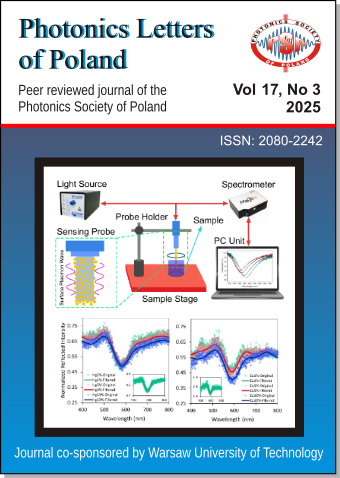Second-order nonlinearity generation in alkali-glass-based optical fibers
DOI:
https://doi.org/10.4302/plp.v17i3.1356Abstract
We analyzed the mechanism of alkali-ions migration taking part in obtaining the frozen ionic potential responsible for the creation of second-order nonlinearity in optical fibers made of silica and other oxide-based glasses. We confirmed that the presence of alkali ions in the oxide glass, together with a high χ(3) value, allows to obtain ionic potential, even though these ions are structural elements of glass rather than impurities. Creation of second-order susceptibility in glass is possible and, depending on alkali-ion concentration, χ(2) can be higher than for a silica-based fiber of the same geometry. Calculated χ(2) reached 0.58 pm/V, and the maximum value obtained for silica-based fiber for the same thermal poling conditions was only 0.33 pm/V.
Full Text: PDF
References
- U. Österberg and W. Margulis, "Experimental studies on efficient frequency doubling in glass optical fibers," Opt. Lett. 12(1), 57 (1987) CrossRef
- H. An and S. Fleming, "Creating second-order nonlinearity in pure synthetic silica optical fibers by thermal poling," Opt. Lett. 32(6), 832 (2007) CrossRef
- H. An and S. Fleming, "Second-order optical nonlinearity in thermally poled borosilicate glass," Appl. Phys. Lett. 89(18), 181111 (2006) CrossRef
- W. Margulis, O. Tarasenko, and N. Myrén, "Who needs a cathode? Creating a second-order nonlinearity by charging glass fiber with two anodes," Opt. Express 17(17), 15534 (2009) CrossRef
- F. De Lucia, D.W. Keefer, C. Corbari, and P.J.A. Sazio, "Thermal poling of silica optical fibers using liquid electrodes," Opt. Lett. 42(1), 69 (2017) CrossRef
- P. Kabaciński, T.M. Kardaś, Y. Stepanenko, and C. Radzewicz, "Nonlinear refractive index measurement by SPM-induced phase regression," Opt. Express 27(8), 11018 (2019) CrossRef
- A. Kudlinski, Y. Quiquempois, G. Martinelli, "Modeling of the χ(2) susceptibility time-evolution in thermally poled fused silica," Opt. Express 13(20), 8015 (2005) CrossRef
- A. Camara, O. Tarasenko, and W. Margulis, "Study of thermally poled fibers with a two-dimensional model," Opt. Express 22(15), 17700 (2014) CrossRef
- F. Bergmann et al., "Measuring the permittivity of fused silica with planar on-wafer structures up to 325 GHz," Appl. Phys. Lett. 124(7), 072902 (2024) CrossRef
- Corning Inc., "Datasheet for Corning Pyrex glass," Aug. 13, 2025. DirectLink
- B. Morova et al., "Fabrication and characterization of large numerical aperture, high-resolution optical fiber bundles based on high-contrast pairs of soft glasses for fluorescence imaging," Opt. Express 27(7), 9502 (2019) CrossRef
- R.W. Boyd, "The nonlinear optical susceptibility," in Nonlinear Optics, 3rd ed., Academic Press, 2008, 1-67. CrossRef
Downloads
Published
How to Cite
Issue
Section
License
Copyright (c) 2025 Alicja Anuszkiewicz, RAFAL KASZTELANIC, RYSZARD BUCZYNSKI

This work is licensed under a Creative Commons Attribution 4.0 International License.
Authors retain copyright and grant the journal right of first publication with the work simultaneously licensed under a Creative Commons Attribution License that allows others to share the work with an acknowledgement of the work's authorship and initial publication in this journal. Authors are able to enter into separate, additional contractual arrangements for the non-exclusive distribution of the journal's published version of the work (e.g., post it to an institutional repository or publish it in a book), with an acknowledgement of its initial publication in this journal. Authors are permitted and encouraged to post their work online (e.g., in institutional repositories or on their website) prior to and during the submission process, as it can lead to productive exchanges, as well as earlier and greater citation of published work (See The Effect of Open Access).




